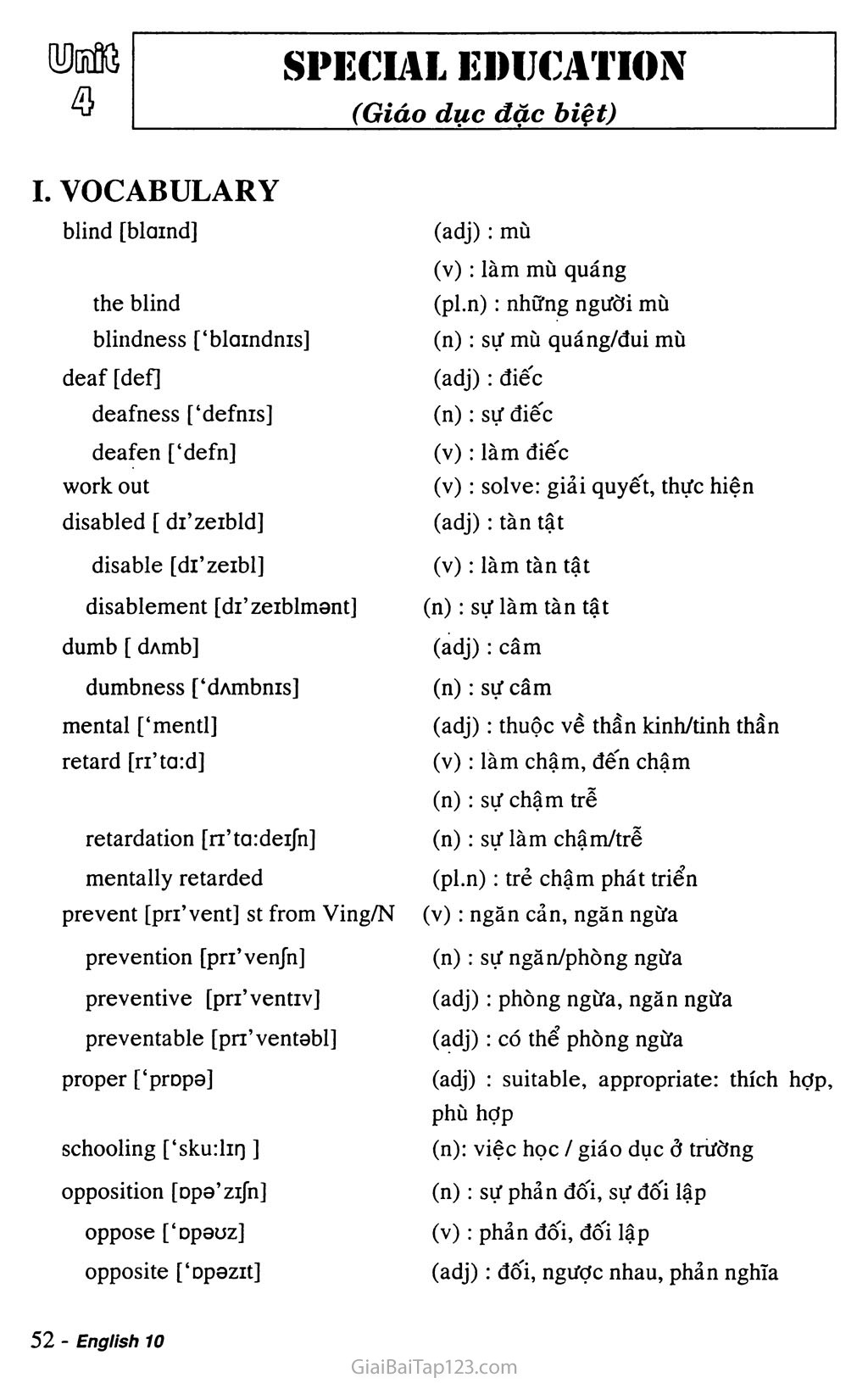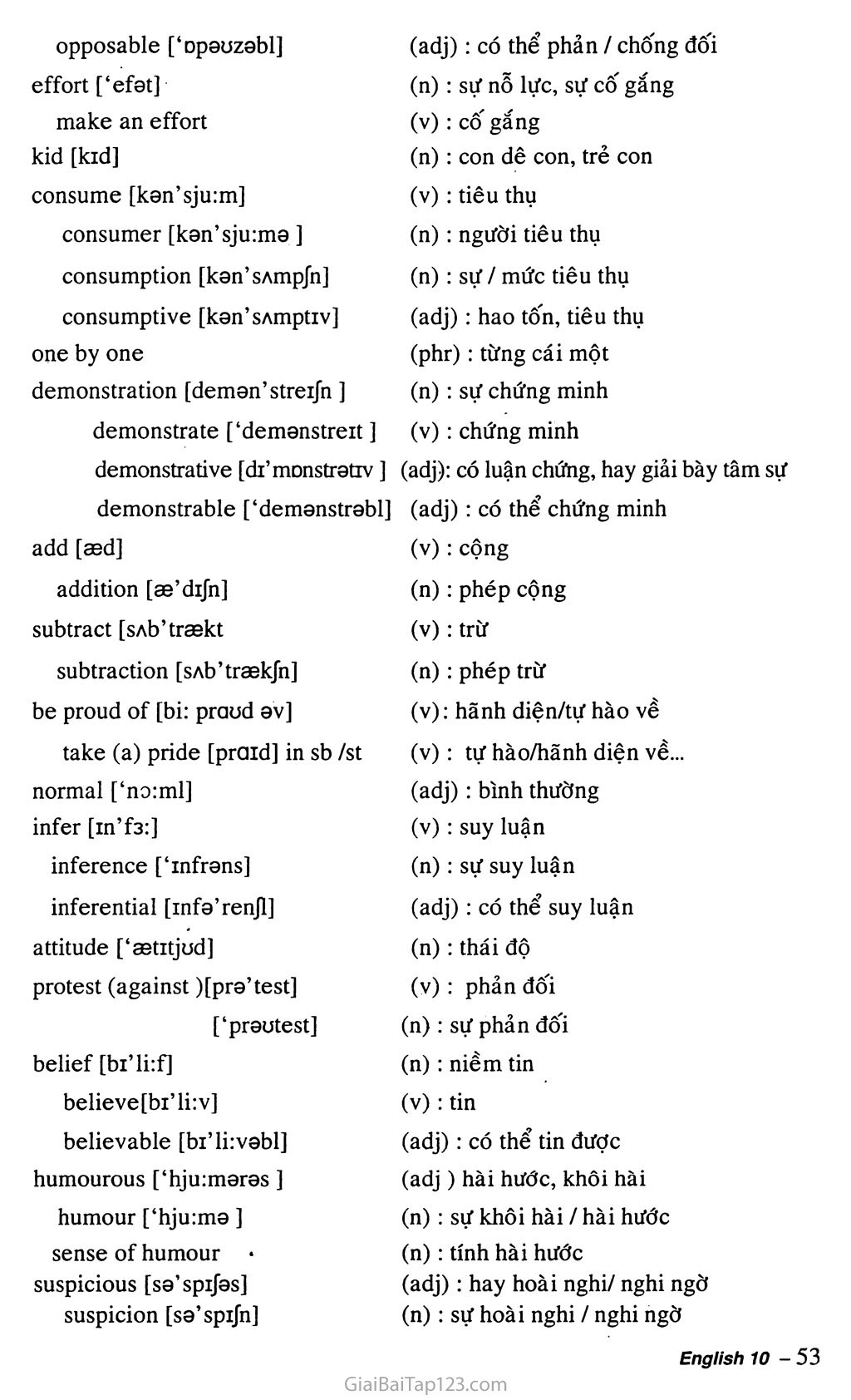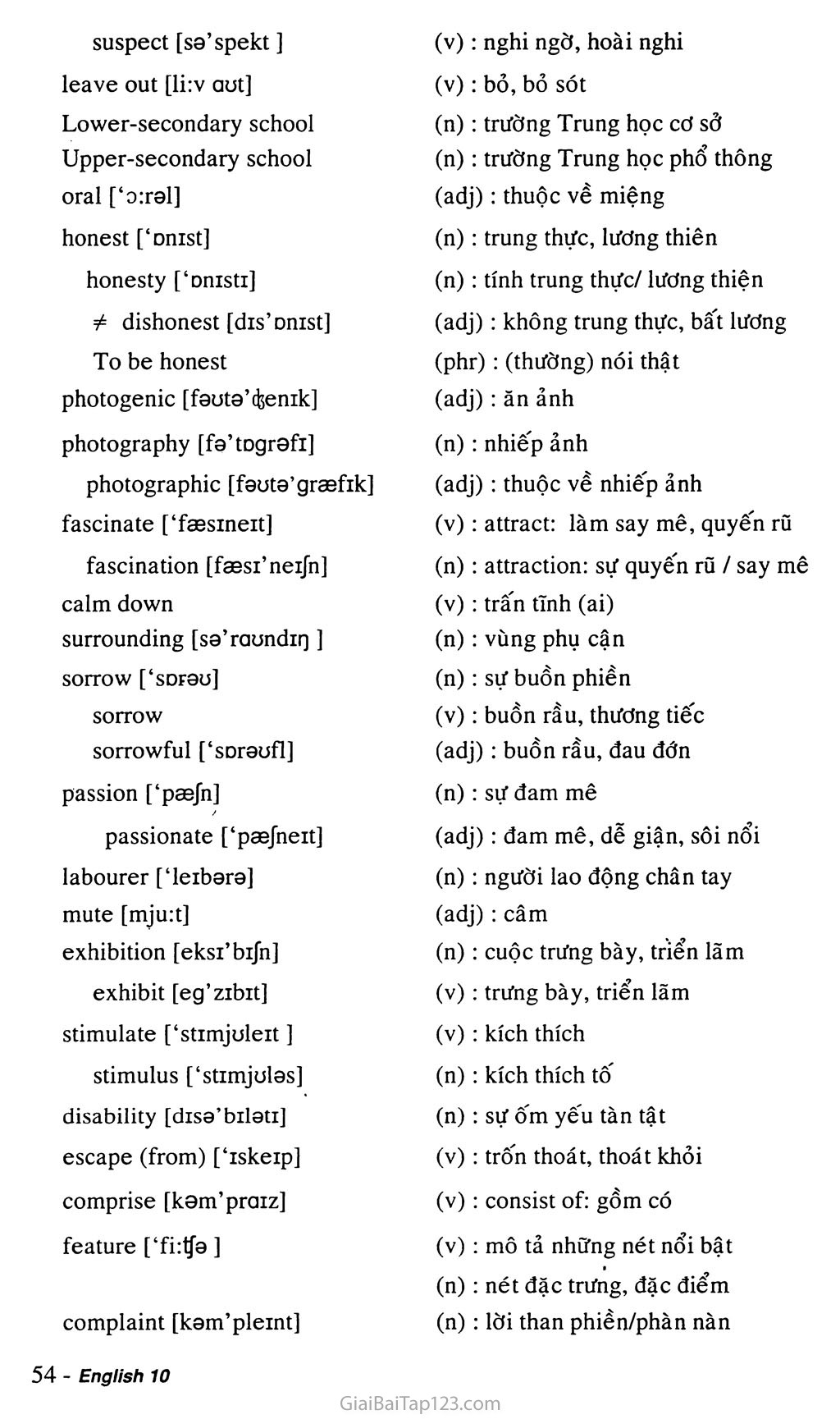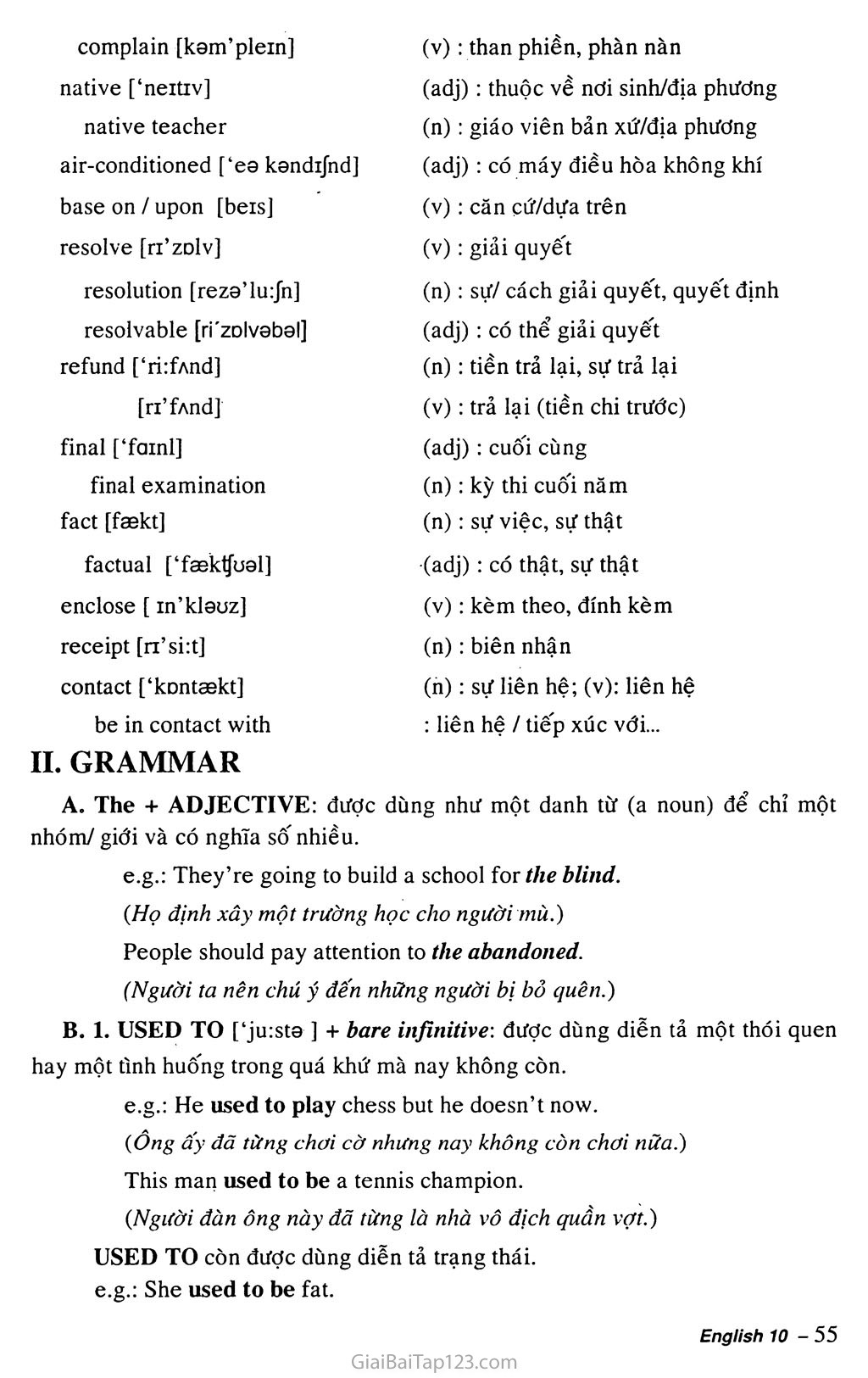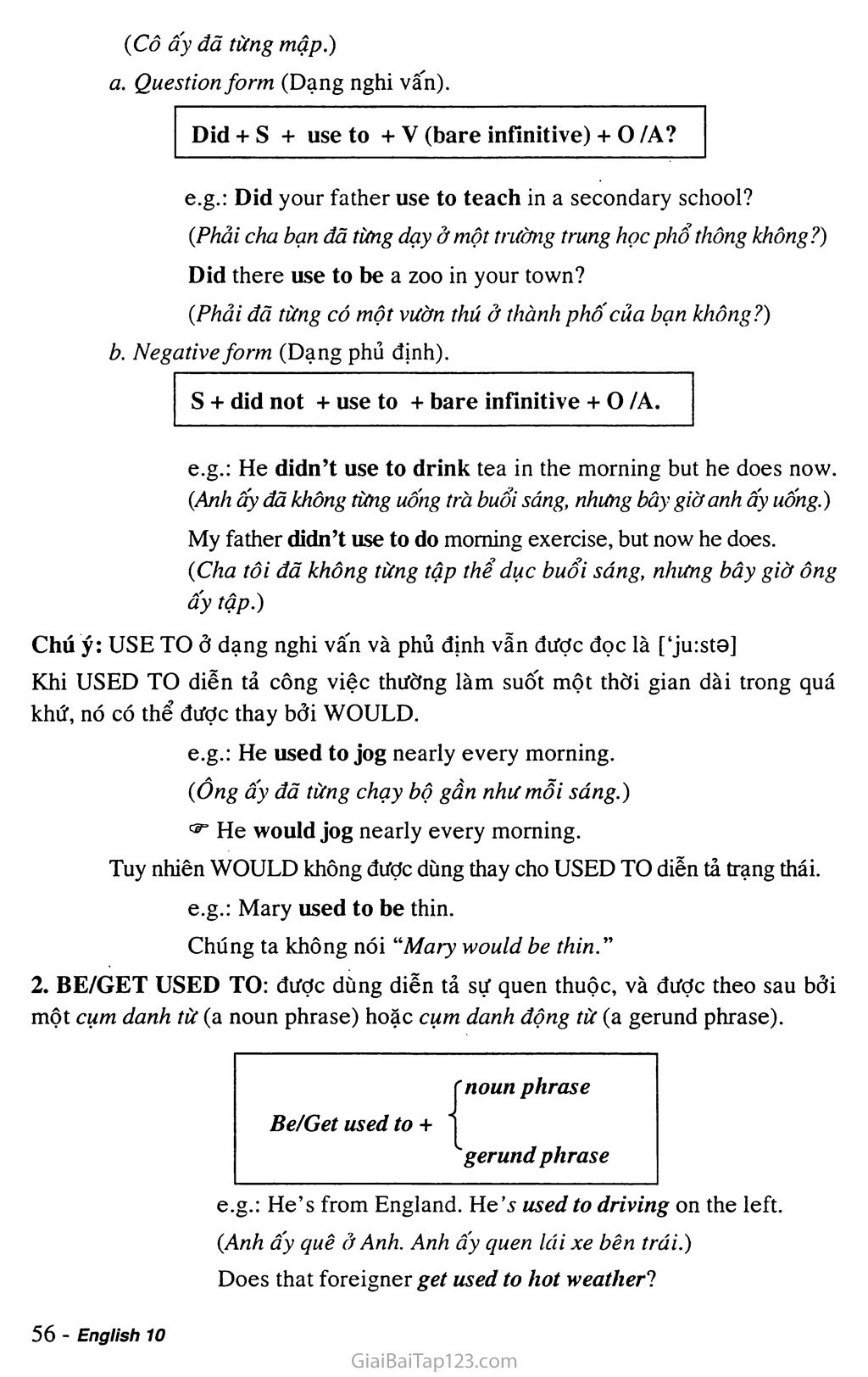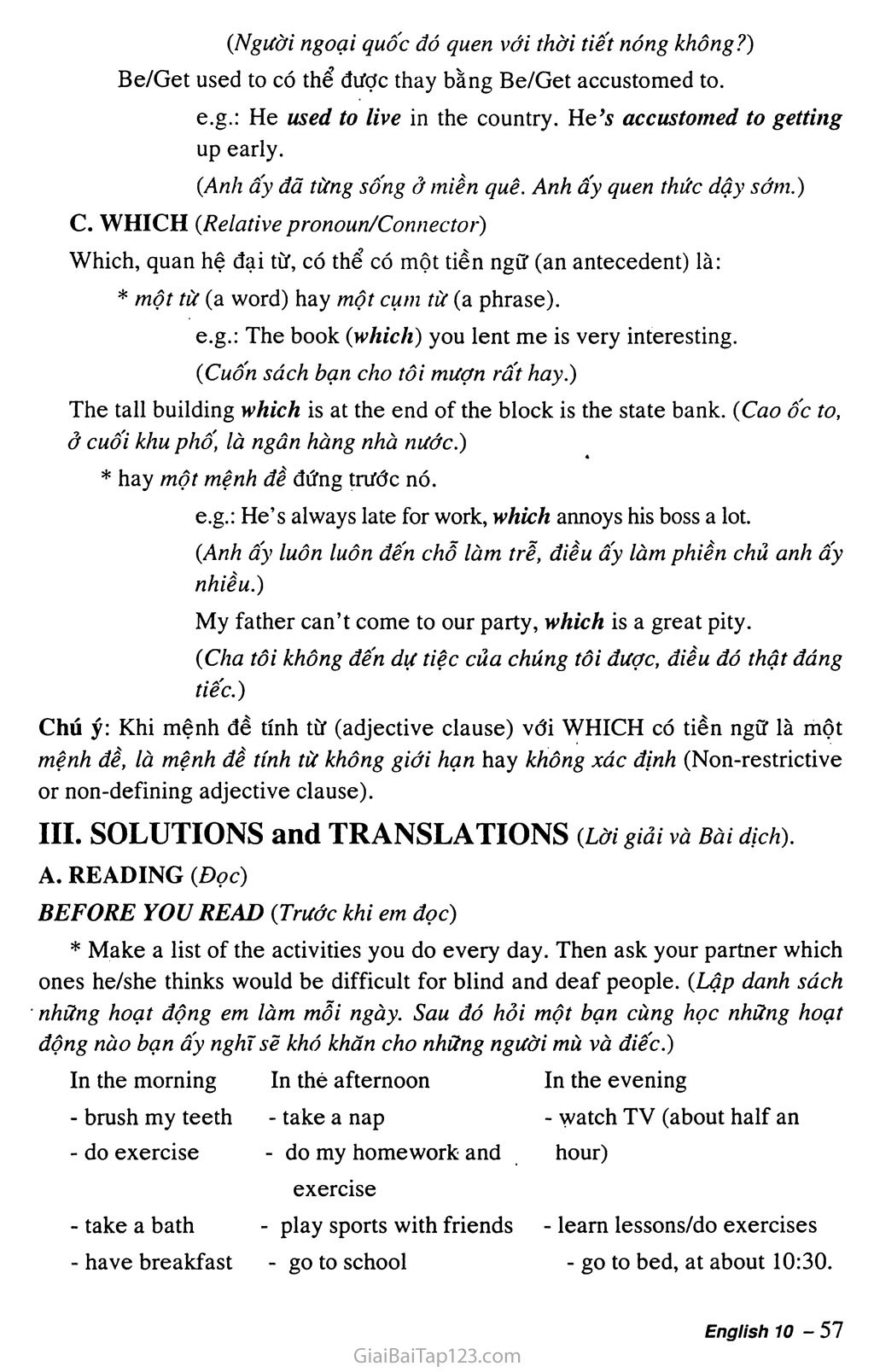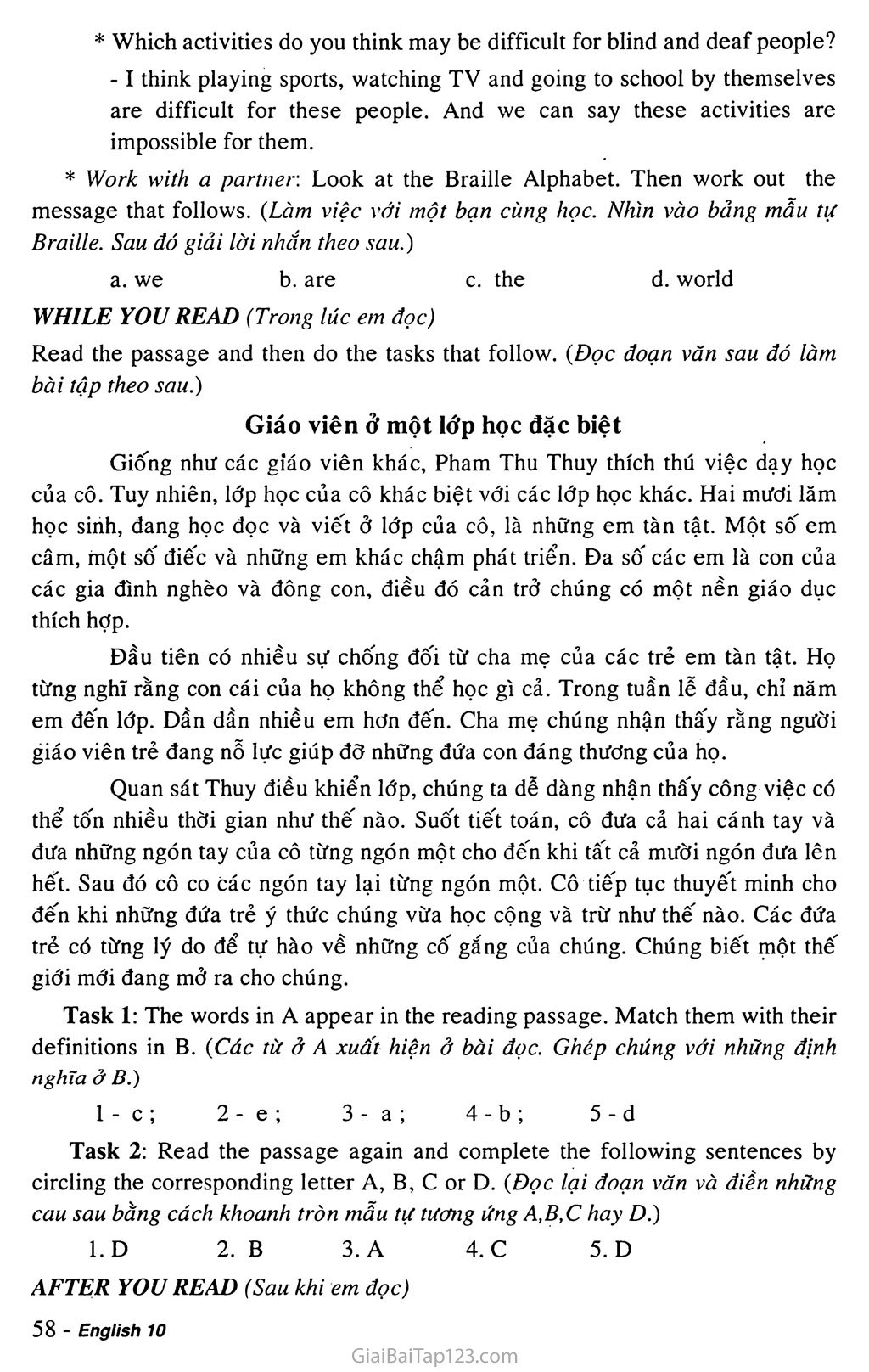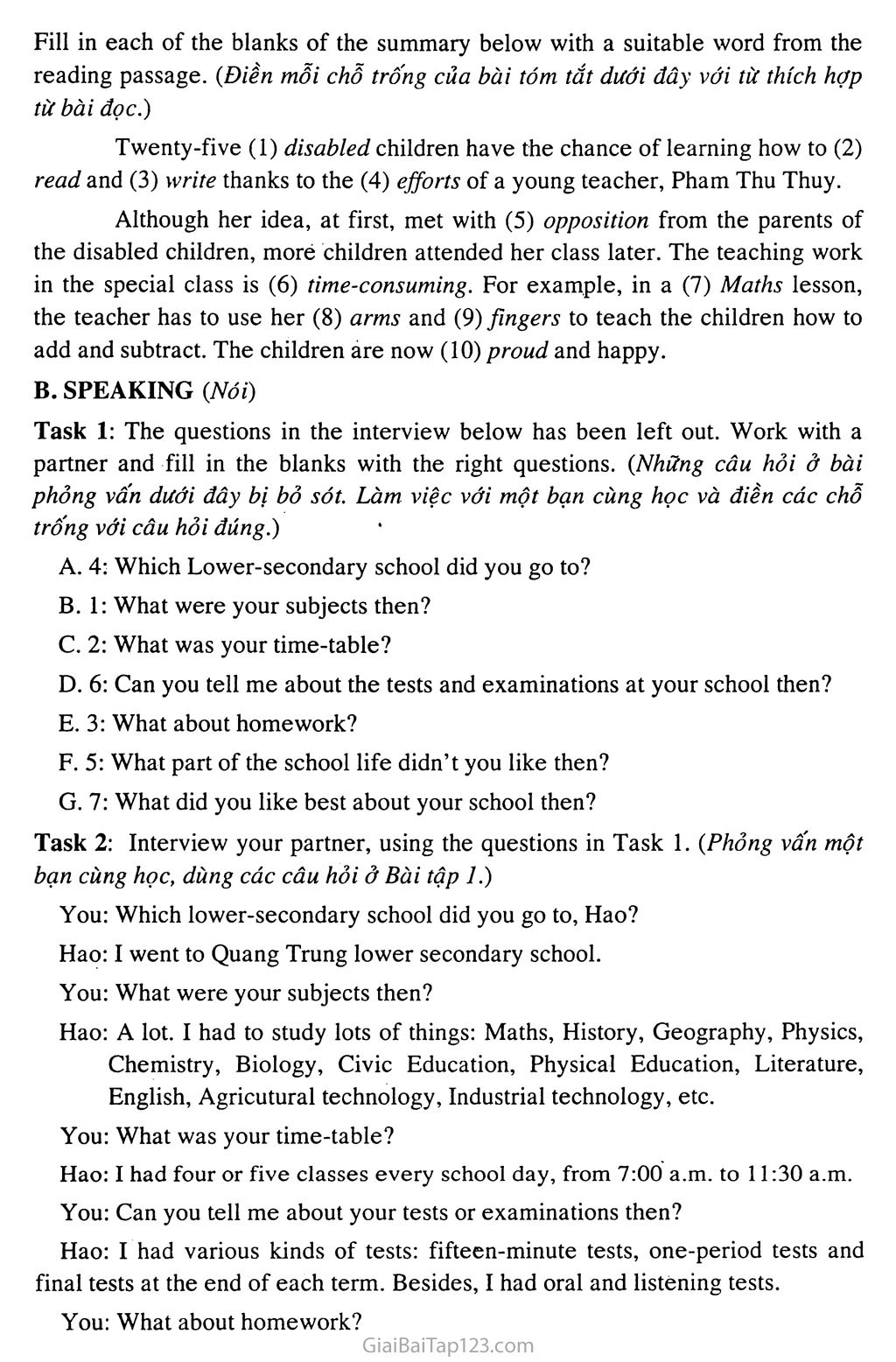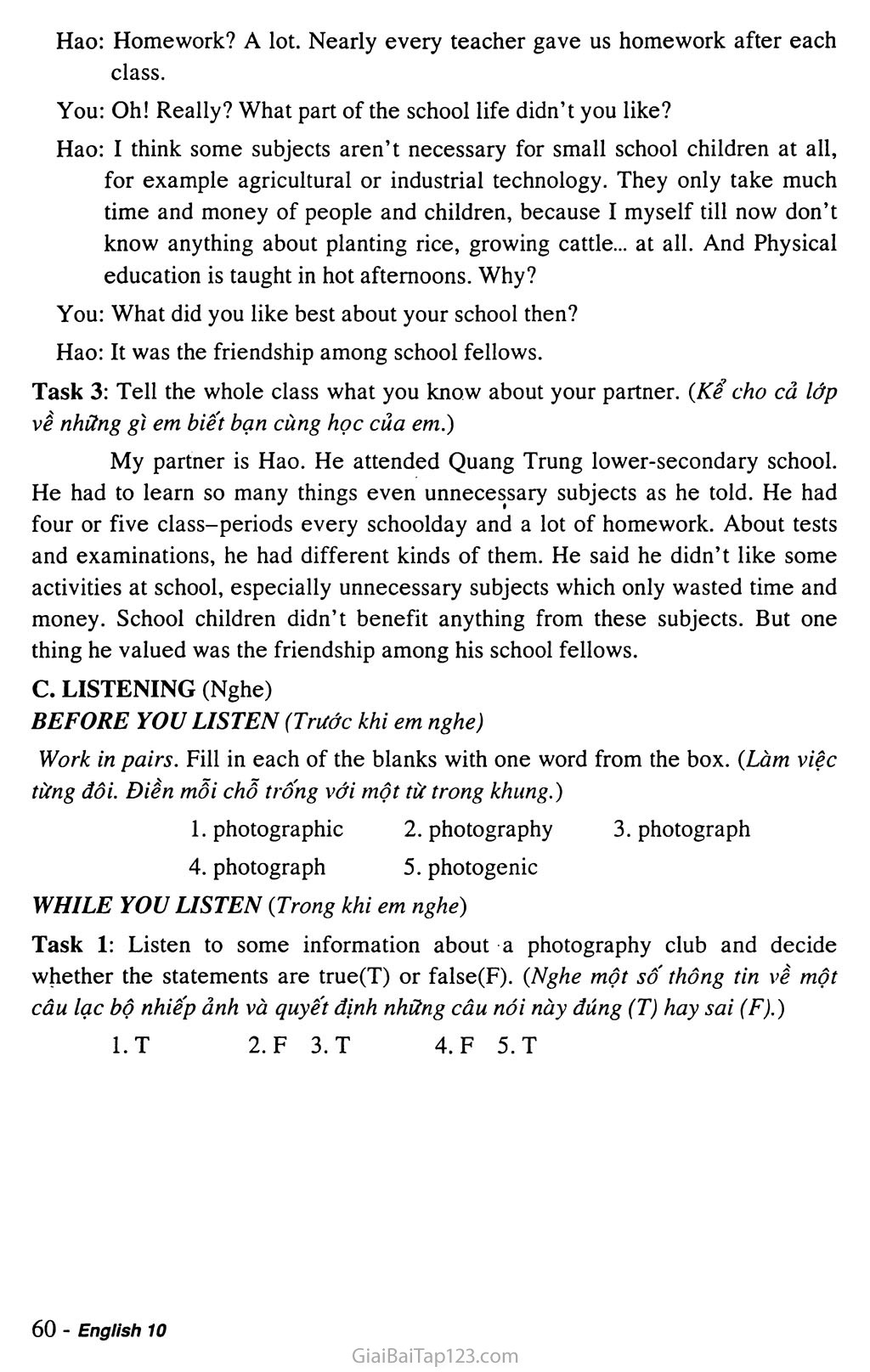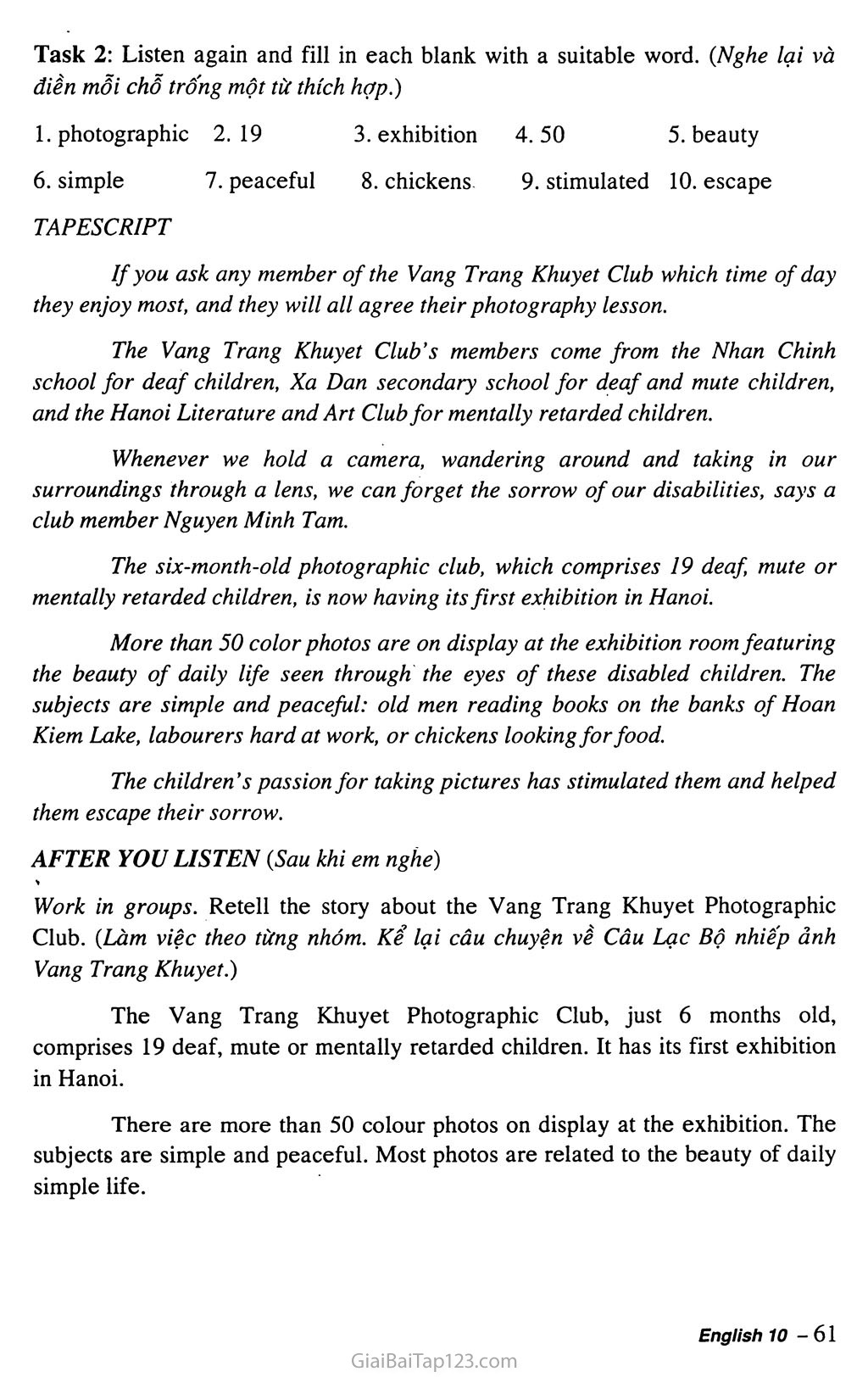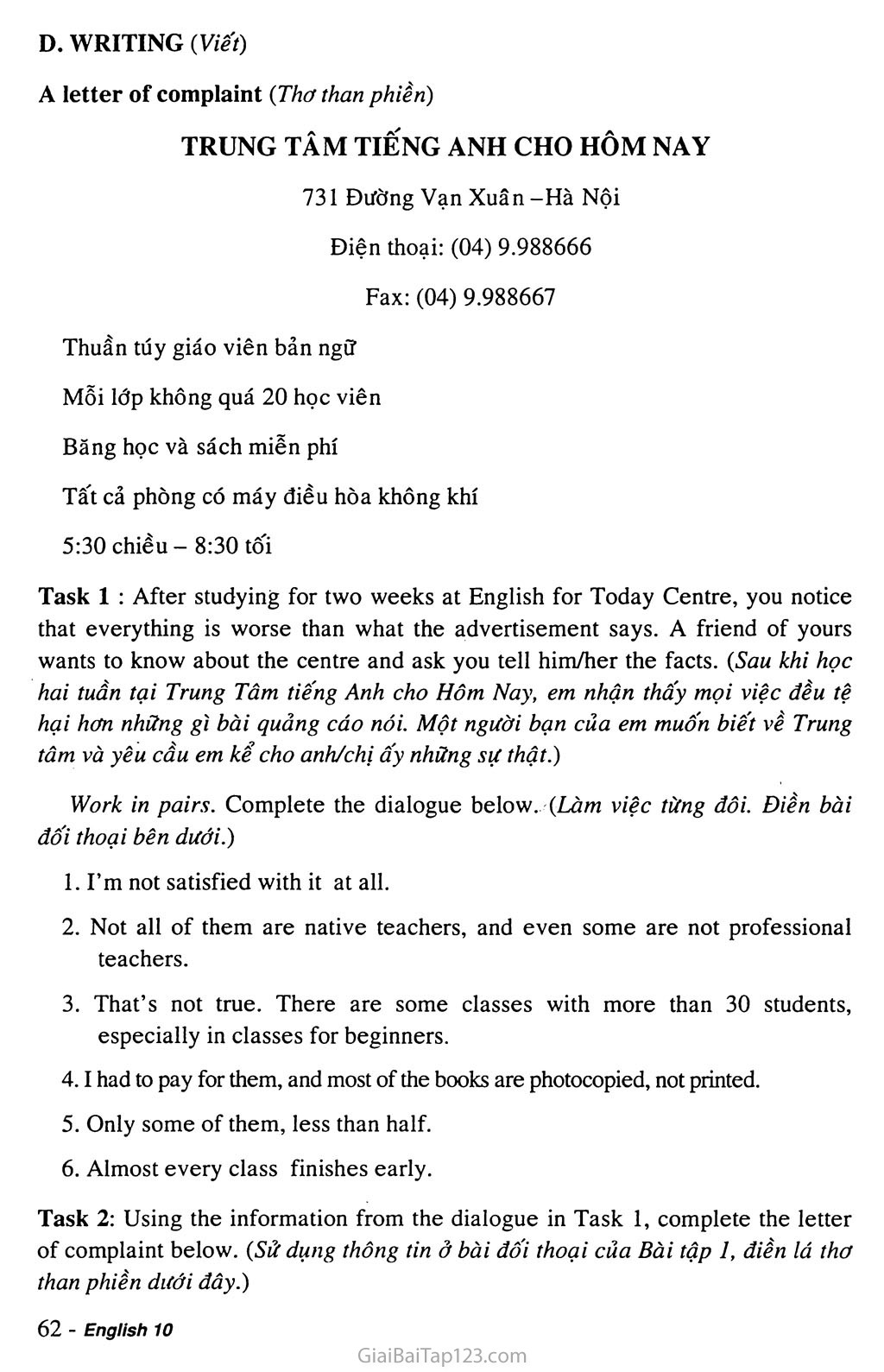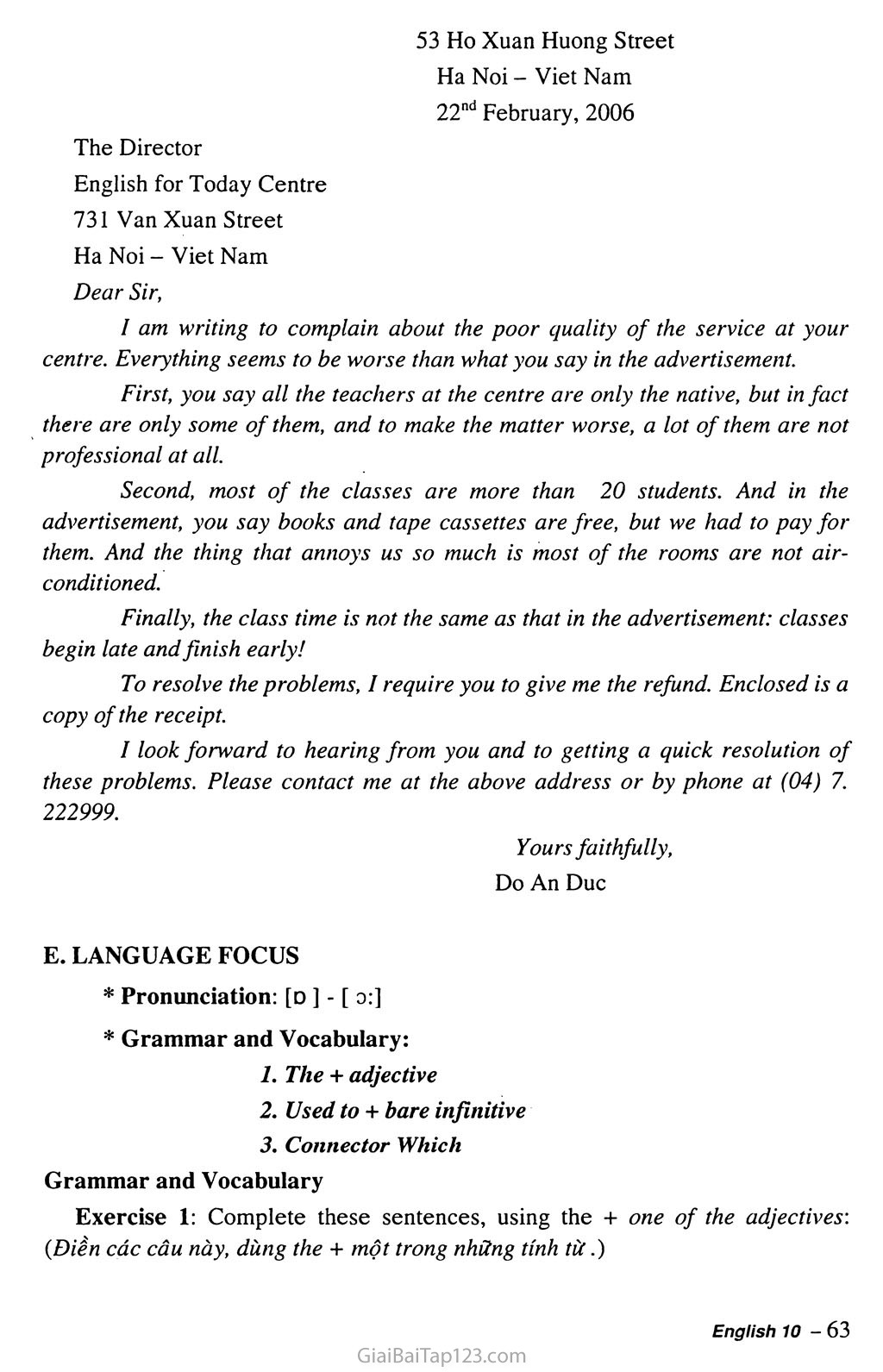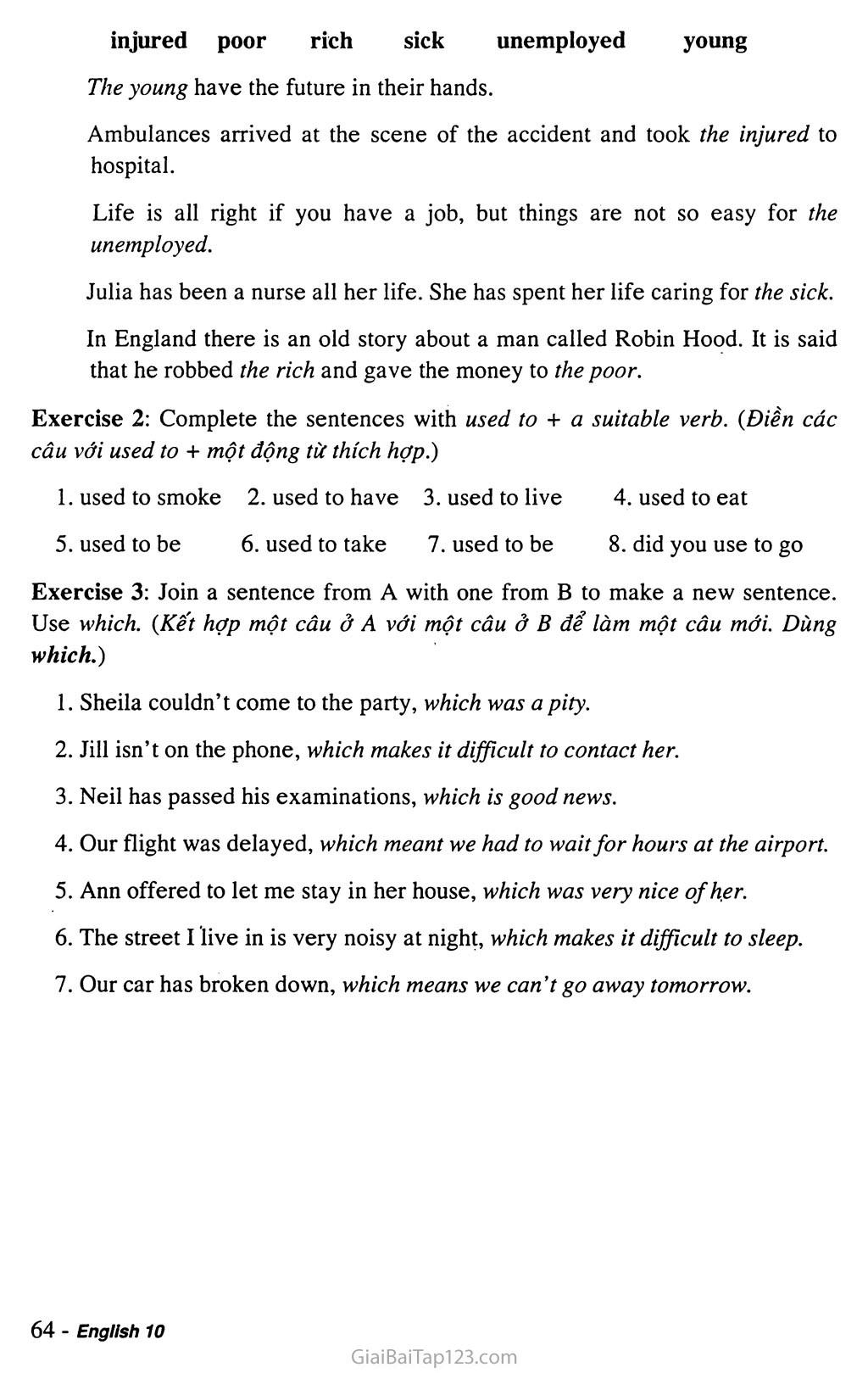Giải tiếng Anh lớp 10 Unit 4: Special Education
OM
4)
SPECIAL EDUCATION
(Giáo dục đặc biệt)
VOCABULARY
blind [blaind]
the blind
blindness [‘blaindnis] deaf [def]
deafness [‘defnis] deafen [‘defn]
work out
disabled [ di’zeibld] disable [di’zeibl] disablement [di’zeiblmant]
dumb [ dAmb]
dumbness [‘dAmbnis]
mental [‘mentl] retard [ri’ta:d]
retardation [n’ta:deijn] mentally retarded
prevent [pri’vent] St from Ving/N prevention [pri’venjn] preventive [pri’ventiv] preventable [pri’ventabl]
proper [‘prDpo]
schooling [‘skudiq ] opposition [Dpa’zijn]
oppose [‘Dpauz] opposite [‘Dpazit]
(adj) : mù
(v) : làm mù quáng (pl.n) : những người mù (n) : sự mù quáng/đui mù (adj) : điếc (n) : sự điếc (v) : làm điếc
(v) : solve: giải quyết, thực hiện (adj) : tàn tật (v) : làm tàn tật (n) : sự làm tàn tật (adj) : câm (n) : sự câm
(adj) : thuộc về thần kinh/tinh thần (v) : làm chậm, đến chậm (n) : sự chậm trễ (n) : sự làm chậm/trễ (pl.n) : trẻ chậm phát triển (v) : ngăn cản, ngăn ngừa (n) : sự ngăn/phòng ngừa (adj) : phòng ngừa, ngăn ngừa (adj) : có thể phòng ngừa (adj) : suitable, appropriate: thích hợp, phù hợp
(n): việc học / giáo dục ở trường
(n) : sự phản đốì, sự đôi lập
(v) : phản đối, đối lập
(adj) : đối, ngược nhau, phản nghĩa
opposable [‘Dpaozabl] effort [‘efat]
make an effort kid [kid]
consume [kan’sju:m] consumer [kan’sjmma ] consumption [kan’sAmpfn] consumptive [kan’sAmptiv]
one by one
demonstration [demon’streifn ] demonstrate [‘demanstreit ] demonstrative [dl’mDnstrativ ] demonstrable [‘demanstrabl]
add [asd]
addition [ae’dijn]
subtract [sAb’traekt
subtraction [sAb’trsekJn]
be proud of [bi: praod av]
take (a) pride [praid] in sb /st
normal [*no:ml]
infer [in’f3:] inference [‘infrans] inferential [infa’renjl]
attitude [‘setitjod]
protest (against )[pra’test] [‘praotest]
belief [bi’li:f] believe[bi’li:v] believable [bi’li:vabl]
humourous [‘hjmmaras ] humour [‘hju:ma ] sense of humour •
suspicious [sa’spijas] suspicion [sa’spifn]
(adj): có thể phản / chống đối (n) : sự nỗ lực, sự cố gắng (v) : cố gắng (n) : con dê con, trẻ con (v) : tiêu thụ
(n) : người tiêu thụ (n) : sự / mức tiêu thụ (adj) : hao tốn, tiêu thụ (phr) : từng cái một (n) : sự chứng minh (v) : chứng minh
(adj): có luận chứng, hay giải bày tâm sự
(adj): có thể chứng minh
(v): cộng
(n): phép cộng
(v) : trừ
(n): phép trừ
(v): hãnh diện/tự hào về
(v) : tự hào/hãnh diện về...
(adj) : bình thường (v):suy luận (n) : sự suy luận (adj): có thể suy luận (n):thái độ (v) : phản đối (n) : sự phản đốì (n): niềm tin (v): tin
(adj) : có thể tin được
(adj) hài hước, khôi hài
(n) : sự khôi hài / hài hước
(n): tính hài hước
(adj): hay hoài nghi/ nghi ngờ (n) : sự hoài nghi/nghi ngờ
suspect [so’spekt ] leave out [li:v out] Lower-secondary school Upper-secondary school oral [‘o:r9l] honest [‘Dnist]
honesty [‘Dnisti]
+ dishonest [dis’Dnist]
To be honest photogenic [fsots’cfeenik] photography [fo’tDgrafl]
photographic [feoto'graefik] fascinate [‘fsesineit]
fascination [fesi’neijn] calm down
surrounding [so’raondiq ] sorrow [1SDF9U]
sorrow
sorrowful [‘sDrgofl] passion [‘psejn]
passionate [‘psefneit] labourer [‘leibaro] mute [mju:t] exhibition [eksi’bijn]
exhibit [eg’zibit] stimulate [‘stimjoleit ]
stimulus [‘stimjolos] disability [disg’bilotij escape (from) [Tskeip] comprise [kam’praiz] feature [‘fi:tfa ]
complaint [kam’pleint]
(v) : nghi ngờ, hoài nghi
(v) : bỏ, bỏ sót
(n) : trường Trung học cơ sở
(n) : trường Trung học phổ thông
(adj) : thuộc về miệng
(n) : trung thực, lương thiên
(n) : tính trung thực/ lương thiện
(adj) : không trung thực, bất lương
(phr): (thường) nói thật
(adj) : ăn ảnh
(n) : nhiếp ảnh
(adj) : thuộc về nhiếp ảnh
(v) : attract: làm say mê, quyến rũ
(n) : attraction: sự quyến rũ / say mê
(v) : trấn tĩnh (ai)
(n) : vùng phụ cận (n): sự buồn phiền (v): buồn rầu, thương tiếc (adj) : buồn rầu, đau đớn (n) : sự dam mê
(adj) : dam mê, dễ giận, sôi nổi (n) : người lao động chân tay (adj) : câm
(n) : cuộc trưng bày, triển lãm
(v) : trưng bày, triển lãm
(v) : kích thích
(n) : kích thích tố
(n) : sự ốm yếu tàn tật
(v) : trốn thoát, thoát khỏi
(v) : consist of: gồm có
(v) : mô tả những nét nổi bật
(n) : nét đặc trưng, đặc điểm
(n) : lời than phiền/phàn nàn
complain [kam’plein]
(v) : than phiền, phàn nàn
native [‘neitxv]
(adj) : thuộc về nơi sinh/địa phương
native teacher
(n) : giáo viên bản xứ/địa phương
air-conditioned [‘ea kandijnd]
(adj) : có máy điều hòa không khí
base on / upon [beis]
(v) : căn cứ/dựa trên
resolve [ri’zDlv]
(v) : giải quyết
resolution [reza’lujn]
(n) : sự/ cách giải quyết, quyết định
resolvable [ri'zDlvabal]
(adj) : có thể giải quyết
refund [*ri:fAnd]
(n) : tiền trả lại, sự trả lại
[ri’fAnd]
(v): trả lại (tiền chi trước)
final [‘fainl]
(adj) : cuối cùng
final examination
(n) : kỳ thi cuối năm
fact [faekt]
(n): sự việc, sự thật
factual [‘faaktfual]
(adj) : có thật, sự thật
enclose [ in’klaoz]
(v): kèm theo, đính kèm
receipt [ri’si:t]
(n) : biên nhận
contact [‘kontaekt]
(n) : sự liên hệ; (v): liên hệ
be in contact with
: liên hệ / tiếp xúc với...
GRAMMAR
The + ADJECTIVE: được dùng như một danh từ (a noun) để chỉ một nhóm/ giới và có nghĩa số nhiều.
e.g.: They’re going to build a school for the blind.
(Họ định xây một trường học cho người mù.)
People should pay attention to the abandoned.
(Người ta nên chú ý đến những người bị bỏ quên.)
1. USED TO [‘ju:sta ] + bare infinitive-, được dùng diễn tả một thói quen hay một tình huống trong quá khứ mà nay không còn.
e.g.: He used to play chess but he doesn’t now.
(Ong ấy đã từng chơi cờ nhưng nay không còn chơi nữa.)
This man used to be a tennis champion.
(Người đàn ông này đã từng là nhà vô địch quần vợt.)
USED TO còn được dùng diễn tả trạng thái, e.g.: She used to be fat.
(Cô ây đã từng mập.')
Question form (Dạng nghi vấn).
Did + s + use to + V (bare infinitive) + o /A?
e.g.: Did your father use to teach in a secondary school?
(Phải cha bạn đã từng dạy ở một trường trung học phổ thông không?) Did there use to be a zoo in your town?
(Phải đã từng có một vườn thú ở thành phố của bạn không?)
Negative form (Dạng phủ định).
s + did not + use to + bare infinitive + o /A.
e.g.: He didn’t use to drink tea in the morning but he does now. (Anh ấy đã không từng uống trà buổi sáng, nhưng bây giờ anh ấy uống.)
My father didn’t use to do morning exercise, but now he does.
(Cha tôi đã không từng tập thể dục buổi sáng, nhưng bây giờ ông ấy tập.)
Chú ý: USE TO ở dạng nghi vân và phủ định vẫn được đọc là [lju:st9]
Khi USED TO diễn tả công việc thường làm suốt một thời gian dài trong quá khứ, nó có thể được thay bởi WOULD.
e.g.: He used to jog nearly every morning.
(Ông ấy đã từng chạy bộ gần như mỗi sáng.)
He would jog nearly every morning.
Tuy nhiên WOULD không được dùng thay cho USED TO diễn tả trạng thái.
e.g.: Mary used to be thin.
Chúng ta không nói “Mary would be thin.”
2. BE/GET USED TO: được dùng diễn tả sự quen thuộc, và được theo sau bởi một cụm danh từ (a noun phrase) hoặc cụm danh động từ (a gerund phrase).
’noun phrase
Be/Get used to +
<
gerund phrase
e.g.: He’s from England. He’s used to driving on the left. (Anh ấy quê ở Anh. Anh ấy quen lái xe bên trái.)
Does that foreigner get used to hot weather?
(Người ngoại quốc đó quen với thời tiết nóng không?)
Be/Get used to có thể được thay bằng Be/Get accustomed to.
e.g.: He used to live in the country. He’s accustomed to getting up early.
(Anh ấy đã từng sống ỗ miền quê. Anh ấy quen thức dậy sớm.)
WHICH (Relative pronoun/Connector)
Which, quan hệ đại từ, có thể có một tiền ngữ (an antecedent) là:
* một từ (a word) hay một cụm từ (a phrase).
e.g.: The book (which) you lent me is very interesting.
(Cuo'n sách bạn cho tôi mượn rất hay.)
The tall building which is at the end of the block is the state bank. (Cao ốc to, ở cuối khu phố, là ngân hàng nhà nước.)
* hay một mệnh đề đứng trước nó.
e.g.: He’s always late for work, which annoys his boss a lot.
(Anh ấy luôn luôn đến chỗ làm trễ, điều ấy làm phiền chủ anh ấy nhiều.)
My father can’t come to our party, which is a great pity.
(Cha tôi không đến dự tiệc của chúng tôi được, điều đó thật đáng tiếc.)
Chú ý: Khi mệnh đề tính từ (adjective clause) với WHICH có tiền ngữ là một mệnh đề, là mệnh đề tính từ không giới hạn hay không xác định (Non-restrictive or non-defining adjective clause).
III. SOLUTIONS and TRANSLATIONS (Lời giải và Bài dịch).
A. READING (Đọc)
BEFORE YOU READ (Trước khi em đọc)
* Make a list of the activities you do every day. Then ask your partner which
ones he/she thinks would be difficult for blind and deaf people. (Lập danh sách những hoạt động em làm mỗi ngày. Sau đó hỏi một bạn cùng học những hoạt động nào bạn ấy nghĩ sẽ khó khăn cho những người mù và điếc.)
In the morning In thê afternoon In the evening
brush my teeth - take a nap - watch TV (about half an
do exercise - do my homework and hour)
take a bath
have breakfast
exercise
- play sports with friends - learn lessons/do exercises - go to school - go to bed, at about 10:30.
* Which activities do you think may be difficult for blind and deaf people? -1 think playing sports, watching TV and going to school by themselves are difficult for these people. And we can say these activities are impossible for them.
* Work with a partner'. Look at the Braille Alphabet. Then work out the message that follows. {Làm việc với một bạn cùng học. Nhìn vào bảng mẫu tự Braille. Sau đó giải lời nhắn theo sau.)
a. we b. are c. the d. world
WHILE YOU READ (Trong lúc em đọc)
Read the passage and then do the tasks that follow. (Đọc đoạn văn sau đó làm bài tập theo sau.)
Giáo viên ở một lớp học đặc biệt
Giống như các giáo viên khác, Pham Thu Thuy thích thú việc dạy học của cô. Tuy nhiên, lớp học của cô khác biệt với các lớp học khác. Hai mươi lăm học sinh, đang học đọc và viết ở lớp của cô, là những em tàn tật. Một số em câm, một số điếc và những em khác chậm phát triển. Đa số các em là con của các gia đình nghèo và đông con, điều đó cản trở chúng có một nền giáo dục thích hợp.
Đầu tiên có nhiều sự chống đối từ cha mẹ của các trẻ em tàn tật. Họ từng nghĩ rằng con cái của họ không thể học gì cả. Trong tuần lễ đầu, chỉ năm em đến lớp. Dần dần nhiều em hơn đến. Cha mẹ chúng nhận thây rằng người giáo viên trẻ đang nỗ lực giúp đỡ những đứa con đáng thương của họ.
Quan sát Thuy điều khiển lớp, chúng ta dễ dàng nhận thây công việc có thể tốn nhiều thời gian như thế nào. Suôi tiết toán, cô đưa cả hai cánh tay và đưa những ngón tay của cô từng ngón một cho đến khi tất cả mười ngón đưa lên hết. Sau đó cô co các ngón tay lại từng ngón một. Cô tiếp tục thuyết minh cho đến khi những đứa trẻ ý thức chúng vừa học cộng và trừ như thế nào. Các đứa trẻ có từng lý do để tự hào về những cố gắng của chúng. Chúng biết một thế giới mới đang mở ra cho chúng.
Task 1: The words in A appear in the reading passage. Match them with their definitions in B. (Các từ Ở A xuất hiện ở bài đọc. Ghép chúng với những định nghĩa ở B.)
1-c; 2 - e ; 3-a; 4-b; 5-d
Task 2: Read the passage again and complete the following sentences by circling the corresponding letter A, B, c or D. (Đọc lại đoạn văn và điền những cau sau bằng cách khoanh tròn mẫu tự tương ứng A,B,C hay D.)
D 2. B 3. A 4. c 5. D
AFTER YOU READ (Sau khi em đọc)
Fill in each of the blanks of the summary below with a suitable word from the reading passage. {Điền mỗi chỗ trống của bài tóm tắt dưới đây với từ thích hợp từ bài đọc.)
Twenty-five (1) disabled children have the chance of learning how to (2) read and (3) write thanks to the (4) efforts of a young teacher, Pham Thu Thuy.
Although her idea, at first, met with (5) opposition from the parents of the disabled children, more children attended her class later. The teaching work in the special class is (6) time-consuming. For example, in a (7) Maths lesson, the teacher has to use her (8) arms and (9) fingers to teach the children how to add and subtract. The children are now (10) proud and happy.
B. SPEAKING {Nói)
Task 1: The questions in the interview below has been left out. Work with a partner and fill in the blanks with the right questions. {Những câu hỏi ở bài phỏng vấn dưới đây bị bỏ sót. Làm việc với một bạn cùng học và điền các chỗ trống với câu hỏi đúng.)
4: Which Lower-secondary school did you go to?
1: What were your subjects then? c. 2: What was your time-table?
6: Can you tell me about the tests and examinations at your school then?
3: What about homework?
5: What part of the school life didn’t you like then?
7: What did you like best about your school then?
Task 2: Interview your partner, using the questions in Task 1. {Phỏng vấn một bạn cùng học, dùng các câu hỏi ở Bài tập 1.)
You: Which lower-secondary school did you go to, Hao?
Hao: I went to Quang Trung lower secondary school.
You: What were your subjects then?
Hao: A lot. I had to study lots of things: Maths, History, Geography, Physics,
Chemistry, Biology, Civic Education, Physical Education, Literature,
English, Agricutural technology, Industrial technology, etc.
You: What was your time-table?
Hao: I had four or five classes every school day, from 7:00 a.m. to 11:30 a.m. You: Can you tell me about your tests or examinations then?
Hao: I had various kinds of tests: fifteen-minute tests, one-period tests and
final tests at the end of each term. Besides, I had oral and listening tests.
You: What about homework?
Hao: Homework? A lot. Nearly every teacher gave US homework after each class.
You: Oh! Really? What part of the school life didn’t you like?
Hao: I think some subjects aren’t necessary for small school children at all, for example agricultural or industrial technology. They only take much time and money of people and children, because I myself till now don’t know anything about planting rice, growing cattle... at all. And Physical education is taught in hot afternoons. Why?
You: What did you like best about your school then?
Hao: It was the friendship among school fellows.
Task 3: Tell the whole class what you know about your partner. (Kể cho cả lớp về những gì em biết bạn cùng học của em.)
My partner is Hao. He attended Quang Trung lower-secondary school. He had to learn so many things even unnecessary subjects as he told. He had four or five class-periods every schoolday and a lot of homework. About tests and examinations, he had different kinds of them. He said he didn’t like some activities at school, especially unnecessary subjects which only wasted time and money. School children didn’t benefit anything from these subjects. But one thing he valued was the friendship among his school fellows.
c. LISTENING (Nghe)
BEFORE YOU LISTEN (Trước khi em nghe)
Work in pairs. Fill in each of the blanks with one word from the box. (Làm việc từng đôi. Điền mỗi chỗ trống với một từ trong khung.)
photographic 2. photography 3. photograph
photograph 5. photogenic
WHILE YOU LISTEN (Trong khi em nghe)
Task 1: Listen to some information about a photography club and decide whether the statements are true(T) or false(F). (Nghe một số thông tin về một câu lạc bộ nhiếp ảnh và quyết định những câu nói này đúng (T) hay sai (F).)
T 2. F 3.T 4. F 5.T
Task 2: Listen again and fill in each blank with a suitable word. (Nghe lại và điền mỗi chỗ trống một từ thích hợp.)
1. photographic 2.19 3. exhibition 4.50 5. beauty
6. simple 7. peaceful 8. chickens 9. stimulated 10. escape
TAPESCRIPT
If you ask any member of the Vang Trang Khuyet Club which time of day they enjoy most, and they will all agree their photography lesson.
The Vang Trang Khuyet Club’s members come from the Nhan Chinh school for deaf children, Xa Dan secondary school for deaf and mute children, and the Hanoi Literature and Art Club for mentally retarded children.
Whenever we hold a camera, wandering around and taking in our surroundings through a lens, we can forget the sorrow of our disabilities, says a club member Nguyen Minh Tam.
The six-month-old photographic club, which comprises 19 deaf mute or mentally retarded children, is now having its first exhibition in Hanoi.
More than 50 color photos are on display at the exhibition room featuring the beauty of daily life seen through the eyes of these disabled children. The subjects are simple and peaceful: old men reading books on the banks of Hoan Kiem Lake, labourers hard at work, or chickens looking for food.
The children’s passion for taking pictures has stimulated them and helped them escape their sorrow.
AFTER YOU LISTEN (Sau khi em nghe)
Work in groups. Retell the story about the Vang Trang Khuyet Photographic Club. (Làm việc theo từng nhóm. Kể lại câu chuyện về Câu Lạc Bộ nhiếp ảnh Vang Trang Khuyet.)
The Vang Trang Khuyet Photographic Club, just 6 months old, comprises 19 deaf, mute or mentally retarded children. It has its first exhibition in Hanoi.
There are more than 50 colour photos on display at the exhibition. The subjects are simple and peaceful. Most photos are related to the beauty of daily simple life.
D. WRITING (Viết)
A letter of complaint (Thơ than phiền)
TRUNG TÂM TIẾNG ANH CHO HÔM NAY
731 Đường Vạn Xuân -Hà Nội
Điện thoại: (04) 9.988666
Fax: (04) 9.988667
Thuần túy giáo viên bản ngữ
Mỗi lớp không quá 20 học viên
Băng học và sách miễn phí
Tất cả phòng có máy điều hòa không khí
5:30 chiều - 8:30 tối
Task 1 : After studying for two weeks at English for Today Centre, you notice that everything is worse than what the advertisement says. A friend of yours wants to know about the centre and ask you tell him/her the facts. (Sau khi học hai tuần tại Trung Tâm tiếng Anh cho Hôm Nay, em nhận thấy mọi việc đều tệ hại hơn những gì bài quảng cáo nói. Một người bạn của em muốn biết về Trung tâm và yêu cầu em kể cho anh/chị ấy những sự thật.)
Work in pairs. Complete the dialogue below. (Làm việc từng đôi. Điền bài đối thoại bên dưới.)
I’m not satisfied with it at all.
Not all of them are native teachers, and even some are not professional
teachers.
That’s not true. There are some classes with more than 30 students, especially in classes for beginners.
4.1 had to pay for them, and most of the books are photocopied, not printed.
Only some of them, less than half.
Almost every class finishes early.
Task 2: Using the information from the dialogue in Task 1, complete the letter of complaint below. (Sử dụng thông tin ở bài đối thoại của Bài tập ỉ, điền lá thơ than phiền dưới đây.)
53 Ho Xuan Huong Street Ha Noi - Viet Nam 22nd February, 2006
The Director English for Today Centre 731 Van Xuan Street Ha Noi - Viet Nam Dear Sir,
I am writing to complain about the poor quality of the service at your centre. Everything seems to be worse than what you say in the advertisement.
First, you say all the teachers at the centre are only the native, but in fact there are only some of them, and to make the matter worse, a lot of them are not professional at all.
Second, most of the classes are more than 20 students. And in the advertisement, you say books and tape cassettes are free, but we had to pay for them. And the thing that annoys US so much is most of the rooms are not air- conditioned.
Finally, the class time is not the same as that in the advertisement: classes begin late and finish early!
To resolve the problems, I require you to give me the refund. Enclosed is a copy of the receipt.
I look forward to hearing from you and to getting a quick resolution of these problems. Please contact me at the above address or by phone at (04) 7. 222999.
Yours faithfully,
Do An Due
E. LANGUAGE FOCUS
Pronunciation: [D ] - [ o:]
Grammar and Vocabulary:
The + adjective
Used to + bare infinitive
Connector Which Grammar and Vocabulary
Exercise 1: Complete these sentences, using the + one of the adjectives: (Điền các câu này, dùng the + một trong những tính từ.)
injured poor rich sick unemployed young
The young have the future in their hands.
Ambulances arrived at the scene of the accident and took the injured to hospital.
Life is all right if you have a job, but things are not so easy for the unemployed.
Julia has been a nurse all her life. She has spent her life caring for the sick.
In England there is an old story about a man called Robin Hood. It is said that he robbed the rich and gave the money to the poor.
Exercise 2: Complete the sentences with used to + a suitable verb. (Điền các câu với used to + một dộng từ thích hợp.)
1. used to smoke 2. used to have 3. used to live 4. used to eat
5. used to be 6. used to take 7. used to be 8. did you use to go
Exercise 3: Join a sentence from A with one from B to make a new sentence. Use which. (Kết hợp một câu ở A với một câu ở B để làm một câu mới. Dùng which.)
Sheila couldn’t come to the party, which was a pity.
Jill isn’t on the phone, which makes it difficult to contact her.
Neil has passed his examinations, which is good news.
Our flight was delayed, which meant we had to wait for hours at the airport.
Ann offered to let me stay in her house, which was very nice of her.
The street I live in is very noisy at night, which makes it difficult to sleep.
Our car has broken down, which means we can’t go away tomorrow.

